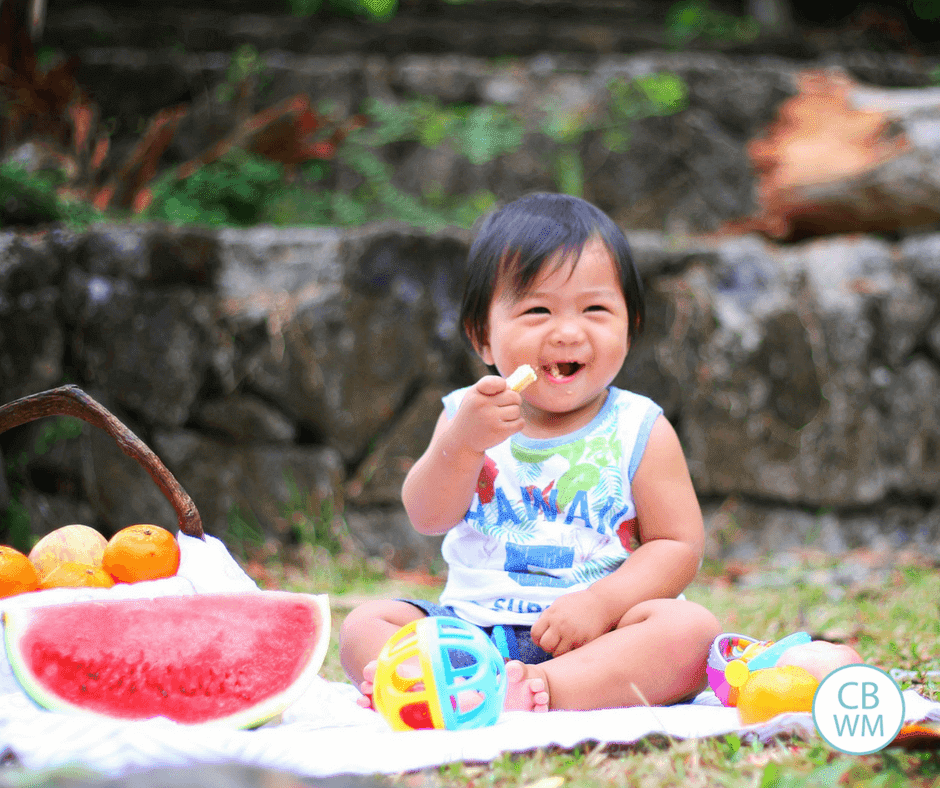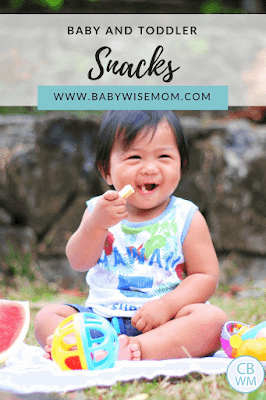Snacks for Babies and Toddlers. Snacks for babies, snacks for toddlers, and good rules to follow for snack time at your house.

Snacks seem innocent and simple enough, but you can easily feed snacks in such a way that you develop bad habits.
The irony in this is that up to this point, you have worked hard to develop consistent eating patterns and habits. Just as “snacking” throughout the day as a baby negatively impacted sleep, the same can happen for older babies and toddlers.
On Becoming Pre-Toddlerwise
Remember to start as you mean to go on. Before you start “snack time,” be sure you think through what you want snack time to be. Pre-toddlerwise says “The best snacks will be low in sugar and salt” (page 59). I agree with that. Healthy snacks are the way to go.
Post Contents
Snack Definition
“A snack is a snack” (page 60). A snack is not lunch nor is it dinner. It is not a meal.
This means it is not large.
You don’t want the snack so large that the child will not eat the next meal. If your child isn’t eating well for the meal following a snack, this does not mean that your child does not need a snack. It simply means your child needs a smaller snack.
Snacks Under One
The only snacks my kids have ever had under the age of one was when they ate finger foods. I have them eat finger foods while sitting at breakfast, lunch, or dinner with the family. This is always after they have eaten their own meal; you don’t want their appetite affected. “You will spoil your dinner!” Kaitlyn eats lunch, then Brayden and I eat lunch and she has her finger foods. It is immediately after her lunch, too, so that we don’t start a “snacking” habit.
It is also feasible to feed your baby snacks while you are out and about. For example, you go out to dinner. Snacks can be a good way to keep baby happy through the meal. Or you are at church. I use little snacks to keep Kaitlyn happy there. She doesn’t sleep at all, so a little snack can keep her quiet. These are examples of your routine serving you rather than you serving your routine. Also, these are moments of exception rather than rule. See the Finger Foods post for more thoughts on those.
Snacks Over One
An actual snack can happen over the age of one. This will likely be necessary a couple of circumstances:
- One is that your child has moved to eating meals with the family and dinner time is too late for him. In this case, your child would get up and have an afternoon snack to tide him over until dinner. With Brayden, I just gave him milk. You can do what you feel is best. Keep it light–only enough to make it. You want him to eat with the family. As your child gets older, the need for this snack should diminish, but the timing will depend on your child and your dinner time.
- Another is that you have dropped the morning nap and your toddler needs a mid-morning snack. I have found this to be true of Brayden. He makes it fine between nap and dinner, but needs something between breakfast and lunch. He usually has two graham crackers or some apple slices…it isn’t much, just enough to keep him happy and amiable.
Snack Time(s)
This is really where “snack time” differs from household to household. For some, snacks happen in the morning between breakfast and lunch. For others, in the afternoon right after the afternoon nap. For still others, it happens at both times.
For us, snack time is in the morning. This is our longest stretch between meals. In the afternoon, the younger children wake up from nap and we eat dinner soon after.
If you have a late breakfast, you might not do a morning snack. You also most likely wouldn’t do a morning snack if your child still takes a morning nap (mine didn’t snack when taking a morning nap).
If you have dinner late, you will need to do an afternoon snack. We have dinner between 5-5:30, so it is easy to make it there for the children, especially since most of the afternoon is spent sleeping.
Do snack time when your child needs it. And keep in mind, this time will change over the years. It can be mornings at one age, afternoons at another, and after school at another.
Rules For Snacks
No matter the age, here are some rules I would apply to snacking:
- Use in moderation (discussed above)
- Keep them light. You don’t want child to fill up on snack and then skip the next meal. He will then need another snack to get him to the next meal, and an undesirable cycle begins.
- Keep them nutritious. Use your own judgement.
- Put it into the routine. Have the snacks be a part of the plan in your day. This will help prevent you from turning to snacking as a norm.
- Do not use food to influence behavior. Though I must say, sometimes this is what we do. In church, for example, when we have a child with us for 3 hours straight, we let the child eat as desired. This is done in consideration of the context. In order to help the child be as pleasant as possible for the benefit of others (and of course ourselves!), we let the child eat snacks.
- Do not use food to pacify sad emotions.
- Keep snacking place consistent. A highchair/booster/table is wise.
- Do not let your child wander the house eating food.
- Offer snacks in the afternoon after nap (as a general suggestion)
Snack Ideas for Kids
Snacks are different from treats. Here are just some ideas to get your mind rolling on what to serve for snacks:
- Cheese
- Whole-grain cereals
- Graham crackers
- Fruit
- Veggies
Related Posts
- Overcoming the Difficulties of Feeding Healthy Snacks to Kids
- 18 Healthy Snacks for After School for Your Kids

